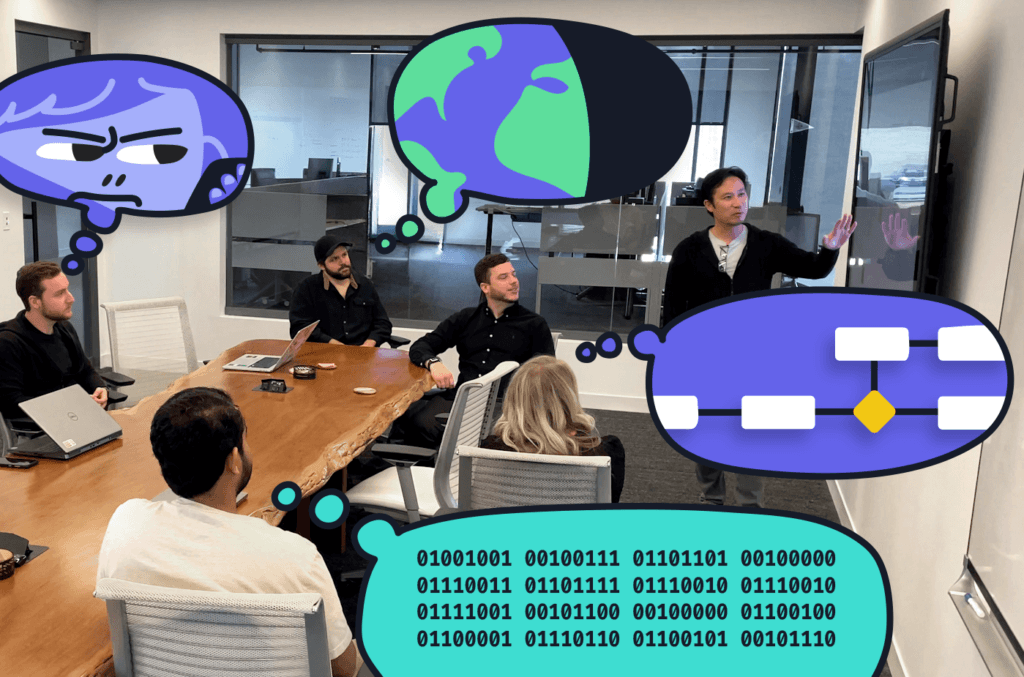
AI’s rapid ascent up the hype curve is tempting businesses to heavily automate processes for efficiency and consistency. Opportunities abound: creative copilots and image generators, flexible data analysis, predictions for equipment failure. AI has the potential to change how we work and make software to help us. But AI comes with subtle risks that can surface where you least expect. To name a few: unclear purpose, unmet user expectations, ethical quagmires. This is where UX and AI intersect. User experience designers (UX Designers) mitigate these risks by ensuring that AI-powered software is valuable, friendly, and safe before you start building it.
4 AI Risks UX Designers can Help Prevent
1. Designers prevent churn by focusing vague UX and AI visions into clear themes of work.
The promise of AI is broad. Your team likely has varied thoughts about how it should fit into your business. It can be hard to focus on any one thing, especially at the beginning of a new initiative. But setting a focused goal is essential. It empowers your team to hit the ground running with a clear objective, a sense of purpose, and a clear definition of success. A project without these ingredients is a recipe for false starts, churn, and burnout.
Why you need a designer
Designers often lead stakeholders, engineers, and users through structured exercises that draw out perspectives, gather business requirements, resolve conflicting visions, establish milestones, and focus teams into action.
- We invite the whole team to describe, sketch, or diagram their perspectives.
- We notice when viewpoints contradict.
- We help teams prioritize work.
Teams leave design workshops with a more unified understanding of the work ahead and a plan to make sure UX and AI are aligned before the work begins.
2. Designers keep AI grounded by learning how it fits into users’ lives.
Given how excited everyone is about AI – you probably can’t trust users to accurately tell you if your product will provide them real value. As entrepreneur Rob Fitzpatrick says in The Mom Test: “Everyone is lying to you.” Users will give you lots of positive feedback to be polite and encouraging. Sometimes users will ask for features or talk about changes they’d like to see, they tend to be unreliable because users know what their problems are but they don’t know how to fix them.
The risk
If you don’t recognize this, you might read too much into positive feedback and rush to put AI in all the wrong places, failing to solve the problem you set out to solve in the first place.
Why you need a designer
Designers are trained to dig beyond these surface reactions using various methods throughout the project to learn how your product will actually fit into their world.
- We use user Interviews, ride-alongs, shadowing, and workshops to learn about users’ lives and spot where AI might empower people or cause havoc.
- We conduct usability tests on quick and inexpensive design prototypes to ensure AI won’t introduce any unnecessary complications or frustrations.
- We help you pick meaningful metrics and analyze subjective feedback to monitor how your product is performing in the wild.
By checking in with users before you build, designers give you more information to help you avoid costly missteps and prioritize AI features that bring real value.
3. Designers mitigate AI’s safety and ethics risks
Usefulness, transparency, human agency, and risk mitigation. These are just a few of the major ethical themes in AI everyone on your team should consider long before you invest in AI.
The risk
We’d all like to think we’ve got a good handle on these issues, but in practice, product teams often get so wrapped up in shipping products that we lose sight of the social impacts of the tools we create. UX and AI fall out of alignment.
Why you need a designer
Designers can help product teams navigate this murky water without slowing things down. On many product teams, a designer’s work ebbs and flows. When we’re not crafting interfaces or testing them with users, we often look forward and outward to the broader context of our work. While engineers are busy building and strategists are busy steering, we can help you anticipate how AI might misbehave or fail to accomplish a task and provide solutions that handle these failures gracefully. We can seek feedback from users that may be underserved. We can suggest simpler alternatives that avoid complex social issues.
Most UX designers aren’t experts in AI ethics, but we have the time, imagination, and human-centered ethic to bring value to these discussions.
4. Designers prevent unnecessary complexity by finding simpler solutions.
The risk
AI comes with risks and unpredictability that is frequently more trouble than it is worth.
- Wildly varying outputs with minor changes in input
- Loss of user autonomy
- Overfitting and underfitting data
- Difficulty explaining AI behavior
- Subtle ethical problems like cultural bias and erasure
Why you need a designer
Designers can help you find simpler solutions by designing UI concepts and discussing them with users, engineers, and stakeholders. By learning what is valuable to your business and your users, we help you solve problems as directly as possible without adding unnecessary conceptual or technical complexity. This could mean working with engineers to find simpler AI solutions, or avoiding AI altogether.
Partner with UX designers to succeed before you start
UX designers bring depth and direction to AI projects. By partnering with us from the start, you gain a clear focus on actionable goals, extra attention to ethical concerns, and a commitment to simplicity. This sets the stage for AI solutions that are not only innovative but also grounded in real value, helping you validate your investment before you fully dive in.
Let’s build awesome things together.
Our approach to Product Design & UX is holistic, integrating business, tech, user needs, and market demands.
You Might Also Like